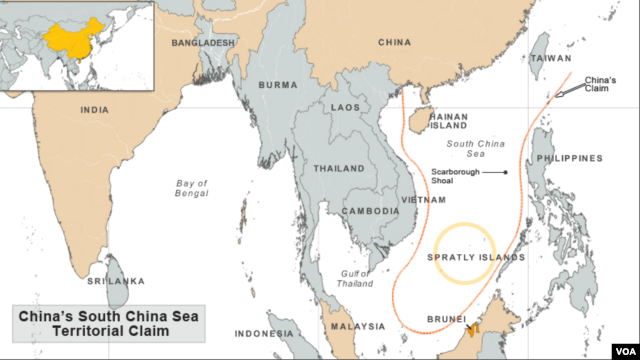
Welcome to As It Is from VOA Learning English! I’m Mario Ritter.
Today we turn to the Philippines, where a powerful storm left a path of destruction. Typhoon Haiyan left hundreds of thousands of people in need of food, water, shelter and medical care.
Also today, we hear about conflicting territorial claims to the South China Sea. And later, we report on changes in the housing market in the United States.
Relief Efforts Develop For Victims of Typhoon Haiyan
But first, more on Typhoon Haiyan. As you may know, the typhoon struck the central Philippines last Friday. Haiyan has been called the most powerful storm ever to strike land. As many as 10,000 people are missing and feared dead.

The United Nations says 660,000 others were displaced The UN is asking for 300 million dollars in aid for recovery efforts. American President Barack Obama has promised “significant” humanitarian aid. The United States and Australia have deployed workers and supplies to the city of Tacloban in Leyte Province.The US Defense Department says the aircraft carrier USS George Washington has been sent to the area to support recovery efforts. For more on the story, listen to VOA news at the top of the hour, Universal Time.
South China Sea Dispute Between China and the Philippines Continues
The Philippines and China have developed an openly unfriendly relationship over their territorial disputes in the South China Sea. But while top officials trade accusations, other people are looking for ways to compromise. Some groups say such a compromise could lead the two sides to explore jointly for oil and natural gas.
Christopher Cruise has more on the story from reporter Simone Orendain from Manila.

The Philippines’ only productive deep-water natural gas project is expected to run dry by 2024. The country badly needs to develop new oil and gas wells in the South China Sea. Philippines Energy Secretary Jericho Petilla says he is hopeful about the possibility for an unlikely collaboration. He says this partnership might take place between Forum Energy, based in Britain, and the China National Offshore Oil Corporation, or CNOOC. He says exploration is necessary.
“The alternative is not to drill, probably forever…. You have to look at the alternatives. You want to preserve your sovereign rights but at the same time, without actually compromising your sovereign rights, can you come up with commercial [exploration], because we need it?”
Both the Philippines and China need the energy trapped underneath the sea floor. But they cannot agree on how to divide it because each country claims the area as its own.
That larger issue remains unsettled. But energy companies tied to the two countries are seeking a way forward. Forum Energy is mainly owned by the Philippine-based Philex Petroleum. That company has been trying to form a partnership with CNOOC to help it meet an agreement to drill two gas wells. The proposal calls for the work to take place at Reed Bank, just west of Palawan Province in the western Philippines.
China claims control over almost all of the South China Sea, which China says includes Reed Bank. The Philippines, Vietnam, Malaysia, Brunei and Taiwan also make partial or total claims to those busy waters.
Philippines officials say they hope to find a way forward by learning from an agreement between Vietnam and China. The two nations agreed to explore waters in the Gulf of Tonkin in the South China Sea. But it is not clear how they would divide the gains from a productive well.
Yang Fang is a researcher at the Center for Asia and Globalization at Singapore’s National University. She says the two nations are depending on the United Nations Convention on the Law of the Sea. Under the UN treaty, competing sides are permitted to make a provisional agreement on water borders. Any final decision on who owns what would not affect this provisional agreement.
Yang Fang says Vietnam has very open, continuing communication with China. She says this takes place both through meetings of higher-level officials and communication between the countries.
“The political will is strong. And also, they can bring [it] down to the practical level.”
Carl Thayer of the Australia Defense Force Academy is expert on South China Sea disputes. He says the agreement between China and Vietnam makes it seem that both parties are cooperating. But he says the central arguments remain unsettled.
Philippines energy officials have been hopeful about making a deal. But President Benigno Aquino has made his policy clear about any partnership between Forum Energy and CNOOC. He says that means the area Forum Energy explores is clearly within the Philippines exclusive economic area. And he says the CNOOC would have to honor the Philippine position in the dispute.
“Any exploitation of the same has to be in conformity with our laws.”
In January, the Philippines brought the issue to the International Tribunal on the Law of the Sea. A ruling in the case could come as soon as next year.
I’m Christopher Cruise.
Multi-Generation Homes Become More Popular
In the United States, homebuilders and developers are seeing growing demand for homes designed to house families of three or more generations. Kelly Jean Kelly has more on the story in this report from Elizabeth Lee.
Alicia Byassee is house hunting in Irvine, California. She went to look for her dream home in a newly built neighborhood. But the house she visited has a different floor plan, or design, from a normal single family home. The house has enough space for her mother to stay and care for her grandparents.
“She’s driving over an hour every day to come see them or to come stay with them and it would just be a lot easier on her and her family if there was something like that they can live in.”

The United States Census Bureau has found an increase in the number of families with three or more generations living together. Many of these families are Hispanic, African American or Asian.
Victor Reigner is a professor of architecture and gerontology at the University of Southern California. He specializes in designing living spaces that meet the needs of older adults. He says the increase in multi-generational homes is driven by economics, not customs.
“A lot of third world countries have had this kind of housing arrangement partly because they didn’t have enough income to be able to purchase additional space.”
I’m Kelly Jean Kelly.
And that’s our show for today. And for the latest news, be listening to VOA at the top of the hour, Universal Time.





